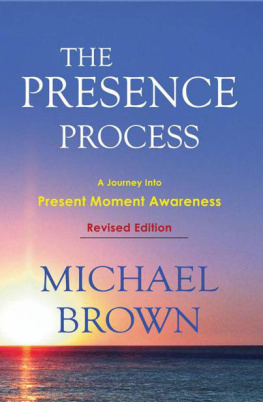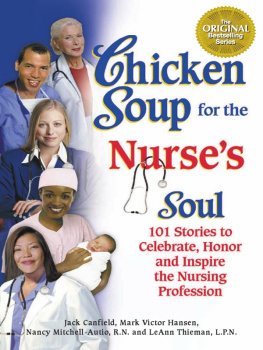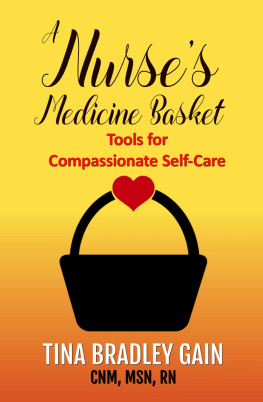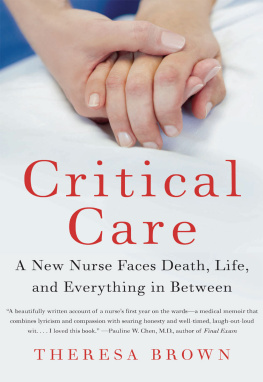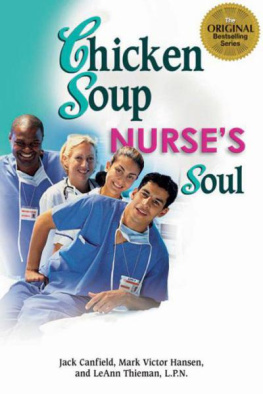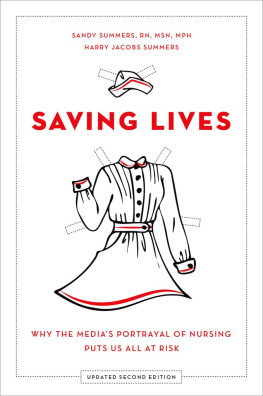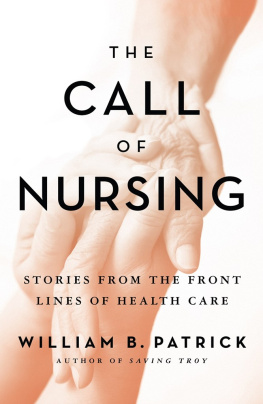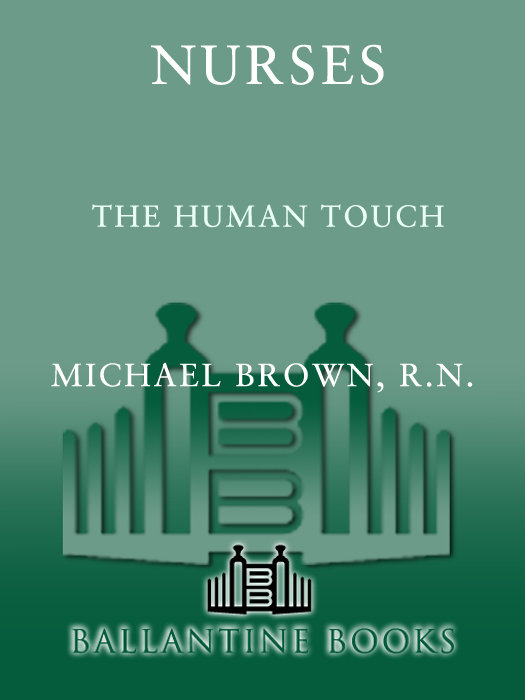VOICES OF CONCERN
Any patient being transported by helicopter is the sickest of the sick. Its just you and that other nurse up there running the show, monitoring the patients status, radioing ahead to the hospital telling them what youve got and what youll need on arrival. And delivering what care you can.
Letting go doesnt mean that if you lose a patient, if a patient dies, that you dont grieve for that person. You do. Ive grieved for every patient Ive lost.
Then theres the Friday night melee when, say, during a code, a family gets into a brawl in the ER, trying to kill each other as their way of expressing grief. It can get so damn crazy some nights.
She looked into my eyes for the full twenty minutes it took her to die. She held my hand. And I wasnt allowed to do anything.
You just never know. You try to learn as much as you can, to do the best job you can. But you just never know.
Ivy Books
Published by Ballantine Books
Copyright 1992 by Michael Brown
All rights reserved under International and Pan-American Copyright Conventions. Published in the United States by Ballantine Books, a division of Random House, Inc., New York, and simultaneously in Canada by Random House of Canada Limited, Toronto.
http://www.randomhouse.com
Library of Congress Catalog Card Number: 9192407
eISBN: 978-0-307-77832-1
v3.1
CONTENTS
ACKNOWLEDGMENTS
This book could not have been written without the help of many people. Foremost, I am indebted to all the nurses who took the time to share their insights and experiences with me. While not everyone is represented in the text, each nurse I interviewed helped extend my understanding of our profession, for which I am profoundly grateful. Id like to take this space to acknowledge those nurses who requested to be identified by their full names: Donna Pffeifer, Kathleen Diamond, Barbara Siebelt, and Frank Bartholemew.
Several people were helpful with research, editorial advice, moral support, professional expertise, and reality testing. Nurses who assisted in this regard were Doris Jacobs, Debbie Mulgrew and the PCU and 2NE crews, Mary Beth Kenny, Doris Keyser, Melva Dill, Paula Goldberg, Kathleen Marion and, in a clutch situation, Mary Beth Hare. The support and direction of Maureen Faulkner were incalculably valuable. Doctors who lent a hand included Mark Novitsky, Anne Tyson, Mike Glackin, David Mozley, and everyone in Crisis. Regards also to my two favorite social workers, Gwen James and Linda Johnson. Civilian input came from Donald Hetz, Alan Doelp, Kathleen Platt Clark, Lyn Watner, and Mike Himowitz. I am particularly obliged to Jim Wooton, Ron Shapiro, Lyn Scholz, and Leslie Walker.
Much appreciation is due my agent, Dominick Abel, who immediately grasped the possibility of a book and remained committed to it even during difficult times. Barbara Dicks, my editor at Fawcett, brought fresh eyes and a deft hand to editing the manuscript.
My gratitude to Val and George Musat, Steve White, Dorene Suarez, Connie Russell, Betty Morgan, and Matt Bokar. All generously supplied me with lodgings allowing me access to areas of the country to which I might not otherwise have been able to travel.
Many thanks to my parents, Edward and Dorothy Brown, for everything and more, and to Guy and Eleanor Simmons, whose enthusiasm for this project never wavered.
Finally, to my wife, Melody Simmons, I can offer only inadequate praise. She encouraged this project from the start and remained enthusiastic even when it dragged on much longer than anticipated. When I became disheartened, she remained steadfast. She coached me through computer nightmares and tape transcriptions, deadline sweats and innumerable revisions. The honesty and zeal she brings to all endeavors is a constant inspiration. For her wisdom and love I am thankful beyond telling.
AUTHORS NOTE
In preparing this book, more than fifty practicing nurses and several RN-tracked students were interviewed about their experiences and opinions. The clinical experience of participants ranged from less than one to over thirty years in the field, spanning forty-one states and most nursing specialities.
This book combines descriptive narrative with first-person perspectives. In either format, the attitudes expressed are those of the nurses described. To convey the emotional impact of particular situations, dialogue has been augmented, characterizations broadened, and details added. All such embellishments are based upon common nursing situations encountered directly by me or related to me by nurses and other health professionals.
In an attempt to guarantee the confidentiality of any patients described and encourage ease of disclosure, participants were informed that as far as possible, no institutions or individuals named would be identified; in most instances not even the city or state where they currently practice is mentioned. Obviously, all patient names and personal characteristics are fictitious.
Each nurse was given a choice of how to be identifiedfull name, first name, or pseudonymdepending upon the degree of confidentiality with which she or he felt most comfortable. The majority wished to be described by first names only, and this became the standard adopted throughout. (Pseudonyms were used upon request. For nurses with the same first name, spelling variations are employed to distinguish individuals when possible.)
Because health care is rife with technical jargon, abbreviations, acronyms, and slang, brief explanations are included within the text in order to avoid frequent reference to a glossary. I hope such insertions do not prove too distracting.
Finally, because nurses are present in so many areas of health care delivery, education, and research, decisions related to space constraints had to be made. It was my choice to place the greatest emphasis on those who have direct patient contact in hospital settings, where the majority practice. This was not meant to slight any other nurses, all of whom pride themselves upon being professional RNs.
INTRODUCTION
News reports about the crisis in health care have become commonplace. In less than a decade, the face of the entire industry has changed. Numerous social and political forcesReaganomics; an explosion in technological advances, epidemics in drug abuse, homelessness and communicable diseases, growing numbers of aging patients, and rising physician fees at odds with tightening insurance restrictionsarrived like overlapping waves, battering the system from within and without.
A major component of the health care crisis is the nationwide shortage of registered nurses. Headlines have described the shortage as pervasive and epidemic, its dire effects touching every aspect of health care. In December 1988, a federal panel appointed to investigate the problem by Otis Bo wen, then secretary of Health and Human Services, issued its first report characterizing the shortage as of significant magnitude and concluded that it was starting to erode the quality of health care as well as access to services. The most dramatic indications of the shortage have been reports of intensive care unit and emergency room closings, respective symbols of medicines most high-tech and essential services.
At the beginning of the 1990s, nationwide estimates of the number of vacancies for positions requiring a registered nurse range from 100,000 to 300,000 and are expected to double by the end of the decade. In January 1991, the




